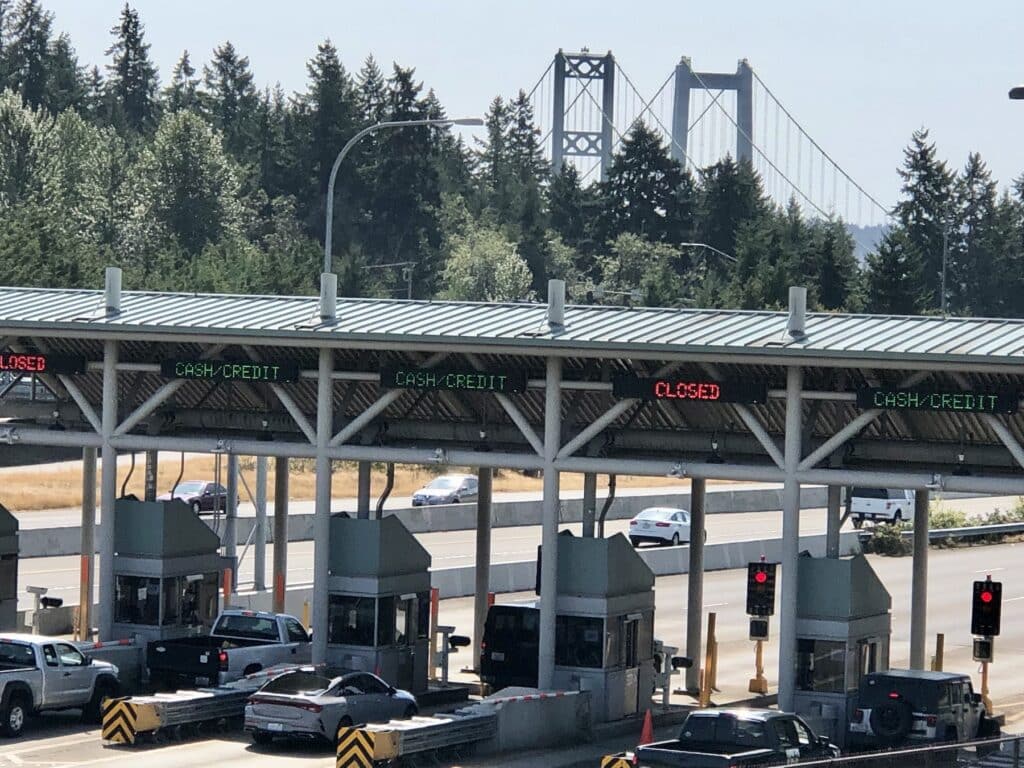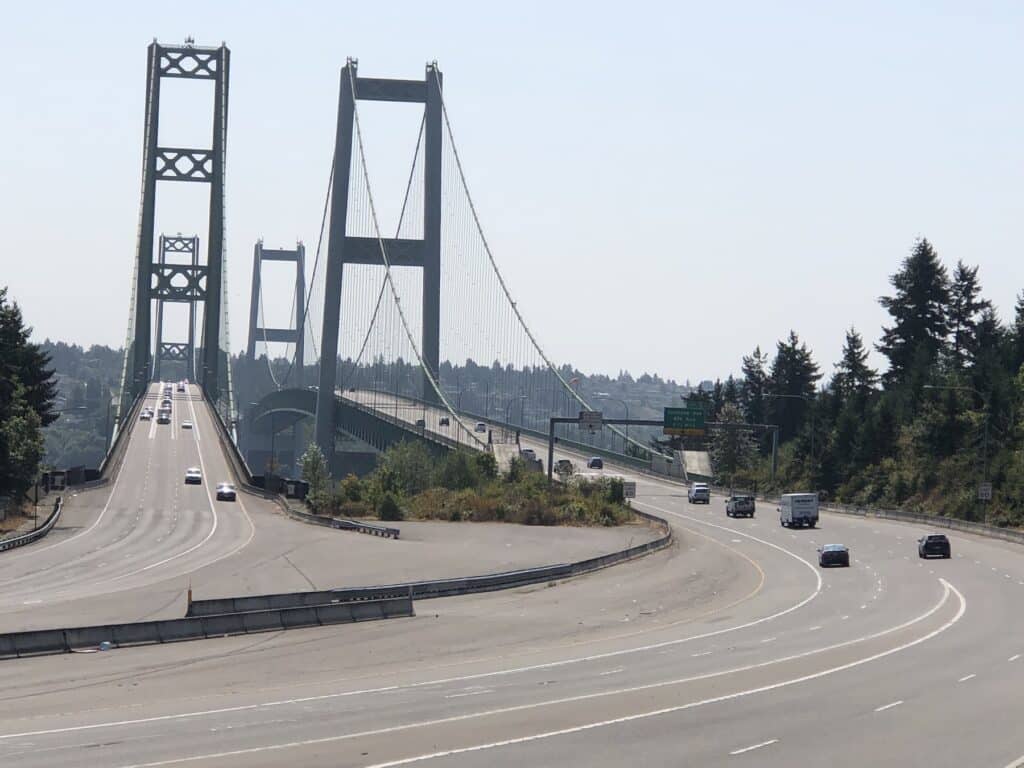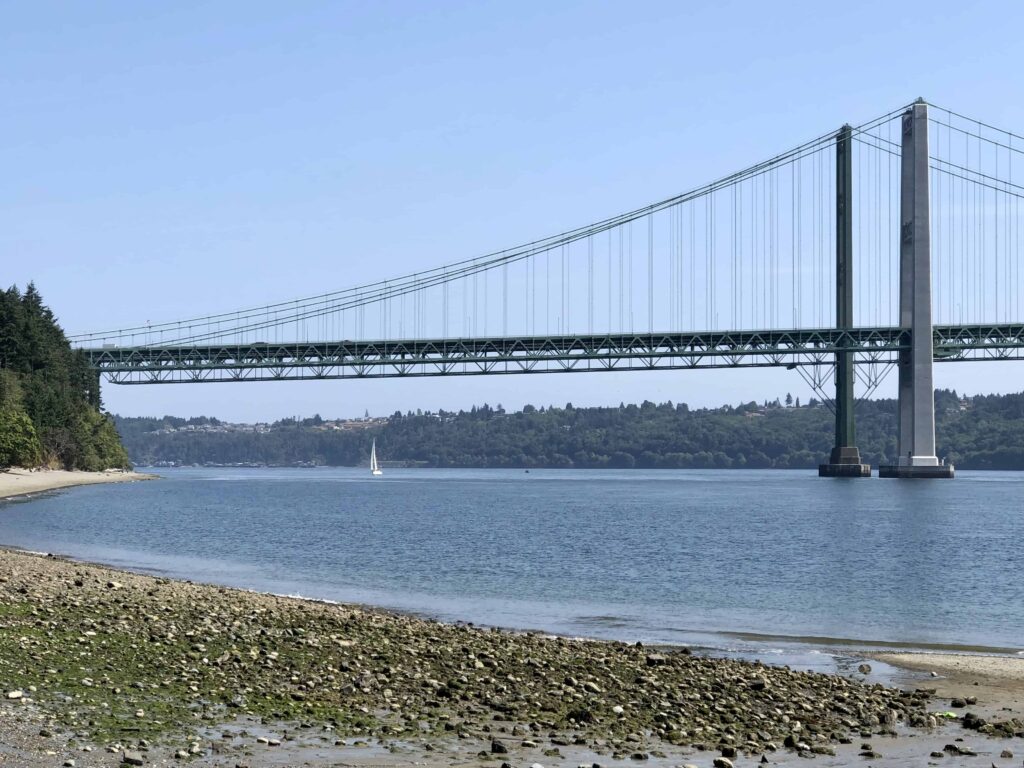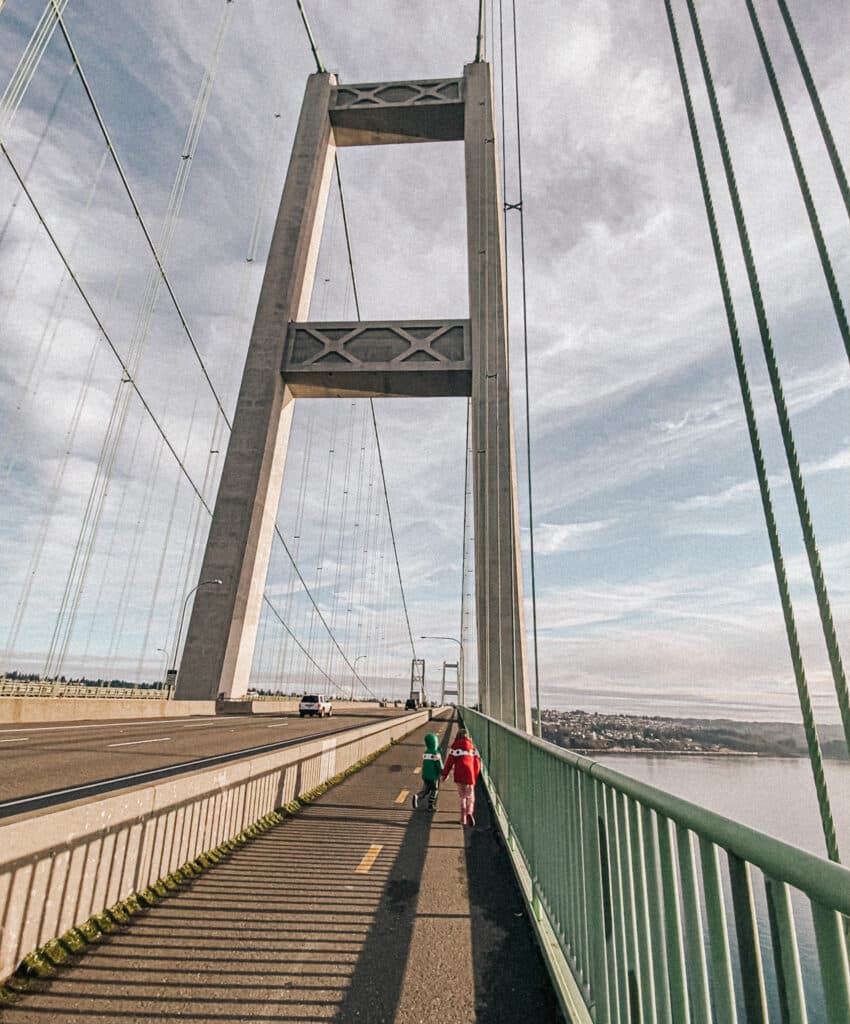Community Government Transportation
Tacoma Narrows Bridge tolling could creep into 2033
The most recent report suggests that tolling of the new Tacoma Narrows Bridge might spill into 2033, beyond the previously anticipated 2032 removal date.
That’s because it will cost about $14 million more to operate the bridge between fiscal years 2023 and 2030, according to the 2024 Washington State Transportation Commission 2024 Annual Tolling Report and Tacoma Narrows Bridge Loan Update. A $6 million rise in projected revenues and fees mitigates the cost increase.

Toll rates are frozen at $4.50 with a Good To Go! pass, $5.50 at the toll booths and $6.50 for pay by mail. Photo by Ed Friedrich
The Transportation Commission, which sets toll rates and policies for state highways and bridges, reports annually to the Legislature on the status of Tacoma Narrows Bridge loans. The report includes when the commission expects loans to be paid off based on traffic, revenue and cost information provided by the state Department of Transportation. The long-range forecasts change from year to year.
For example, the 2021 and 2022 reports, like 2024’s, projected that tolls would continue into early Fiscal Year 2033. But the 2023 review expected the bridge’s financial obligations to end in Fiscal Year 2032 (the state fiscal years run July 1 to June 30), said Transportation Commission Deputy Director Carl See.
Insurance, operating costs rising
Projected cost increases during 2023-30 include $2.3 million for insurance, $5.1 million for credit card/bank fees, $3.8 million for printing and postage, and $2.9 million for civil penalty processing. They would be offset by $6 million in increased revenues, primarily from civil penalties.

The new Tacoma Narrows Bridge is expected to be paid off in fiscal 2032 or early 2033. Photo by Ed Friedrich
Insurance rates are up because the global market has suffered large losses, mostly related to weather events, said Chris Foster of the WSDOT Toll Division. Also, as the bridge’s value increases, so do the costs of repair or replacement should it become damaged or unusable. The same is true for business interruption. As projected revenue increases with traffic, the cost to insure the business interruption portion of the policy continues to increase.
Costs rise with traffic
Credit card and bank fee costs are rising because of higher credit card fees, more bridge traffic and additional security of cardholder data, Foster said.
More drivers correlate to more toll bills and other mailed correspondence, and thus a rise in printing and postage costs. Mailing costs also increased in recent years, Foster said.
Customer service vendor increases and mailing rates account for most civil penalty adjudication costs.
Revenue increases are the result of higher interest rates in the short term and increasing fee revenue from civil penalties.

The bridge cost $729 million to build plus $57.6 million in sales taxes. Photo by Ed Friedrich Ed Friedrich / Gig Harbor Now
State law allows tolls to pay only for construction bonds, operations and maintenance of the eastbound bridge that opened on July 16, 2007. The original plan called for the $729 million structure to be paid off and tolls removed in 2030, when the state satisfied $681 million in construction bonds ($1.48 billion with interest). About $892 million has been paid through the end of Fiscal Year 2023, said Aaron Halbert, Transportation Commission financial analyst.
State loans, contributions locked fares
Since then, the state took steps to hold down and ultimately freeze escalating toll rates. The bridge financing structure was set up with unique scheduled, automatic increases in debt service payments.
The state first deferred until 2013 payment of $57.6 million in state and local sales taxes for labor and materials in building the bridge, to be paid over 10 years. A state loan further delayed that until 2031, after the bonds are paid.
In 2018, state Rep. Jesse Young, R-Gig Harbor, led an effort to pass legislation to loan the bridge fund up to $85 million between fiscal years 2020 and 2030. It will be the last money owed, after bonds and sales tax.
The Transportation Commission’s 2024 report forecasts that $85 million won’t be enough. Instead, the state needs about $92.3 million. This difference is what could extend tolls into fiscal 2033, along with a reduction in revenues in 2032-32 because of continued cost increases mentioned earlier.
In 2022, the Legislature committed another $130 million from the general fund — $3.25 million per quarter — that doesn’t need to be repaid. Bill sponsor Sen. Emily Randall, D-Bremerton, and others believed it was unfair that the Tacoma Narrows Bridge was the only project to be completely funded by toll payers. The contribution helped reduce rates by 75 cents and froze them at $4.50 with a Good To Go! pass, $5.50 at the toll booths and $6.50 for pay by mail.
In 2021, the Legislature also granted the bridge account $15.7 million in federal American Rescue Plan Act funds to mitigate reduced toll revenues caused by the COVID pandemic. This amount does not need to be repaid.
Not much to be repaid in FY 2033
The 2024 report estimated that only $2.9 million would remain to be paid in fiscal 2033. That wouldn’t take long considering the bridge brings in about $80 million a year.
“We do hope this can be paid early into FY 2033, however factors such as closing costs may stretch this past the Q1 of FY 2033,” Halbert said. “And again, this depends on future cash flow and payment plans by WSDOT.”
After the bridge is paid off, maintenance will be covered through the regular transportation budget like all other state bridges and highways, unless the law is changed.

